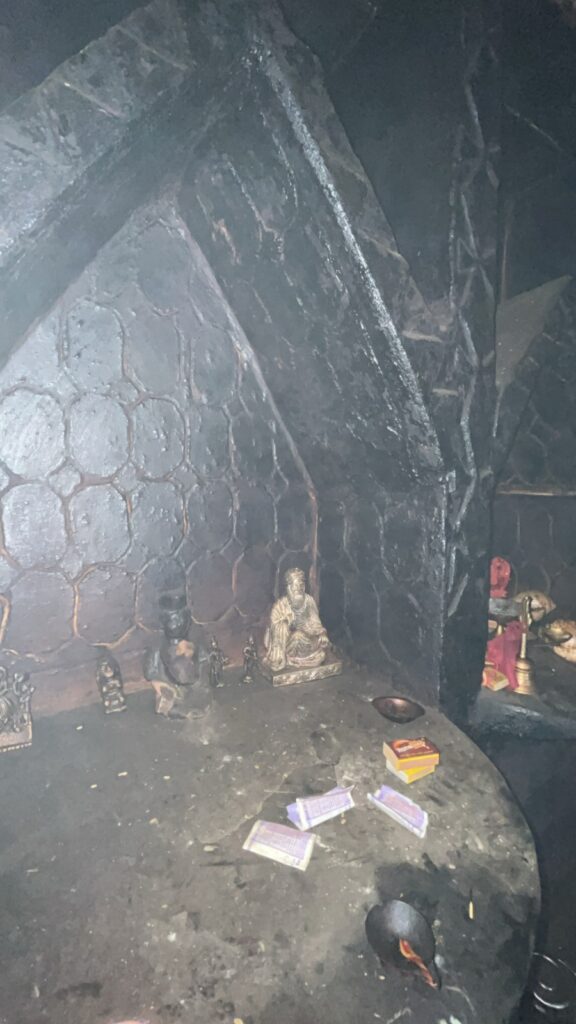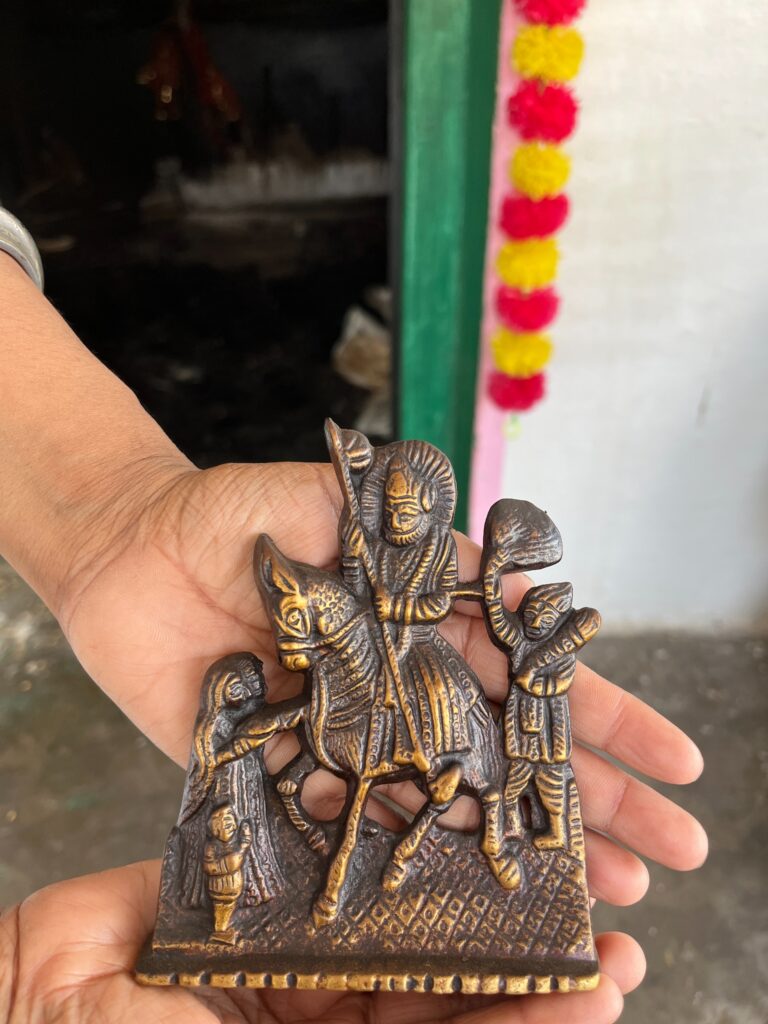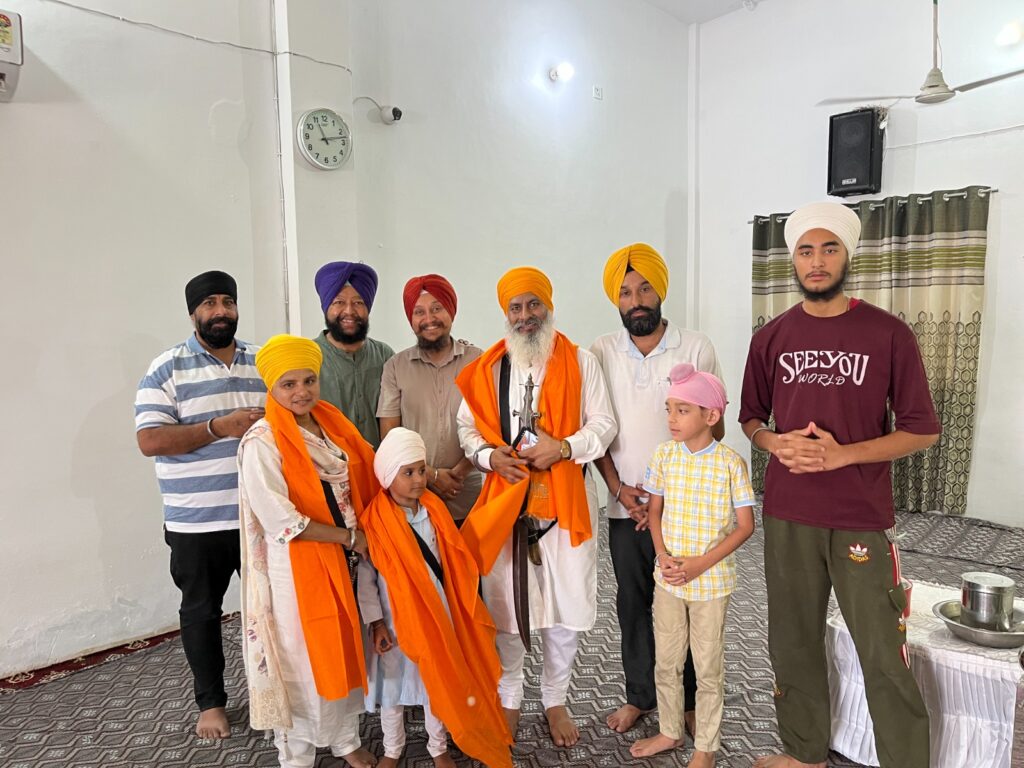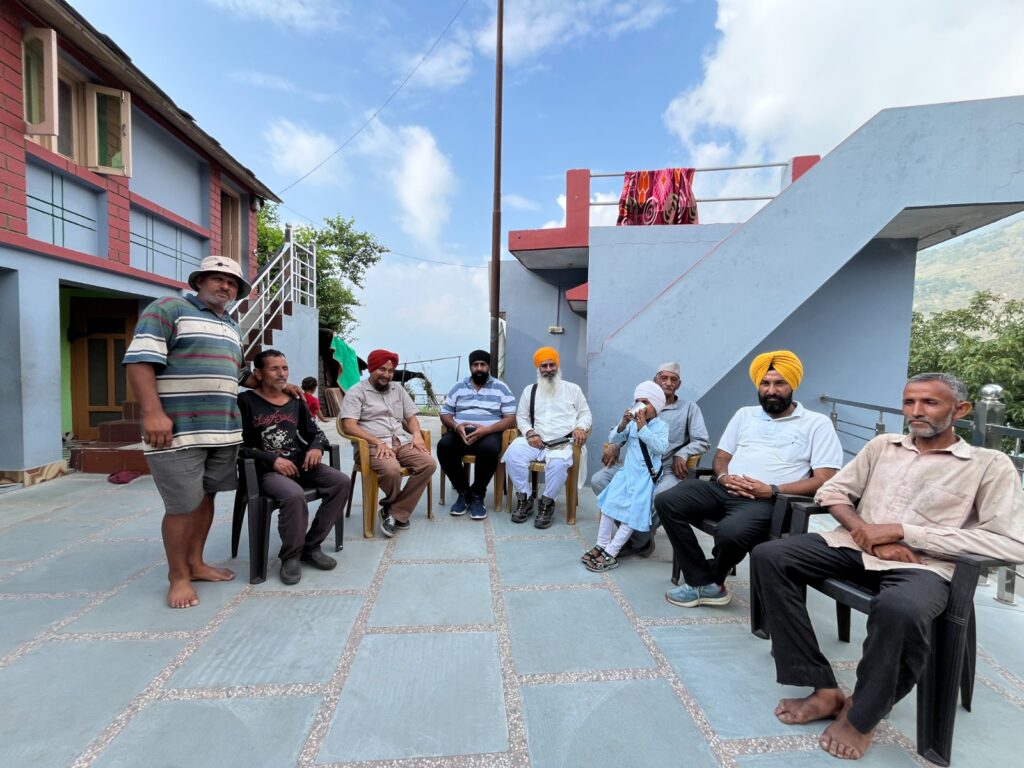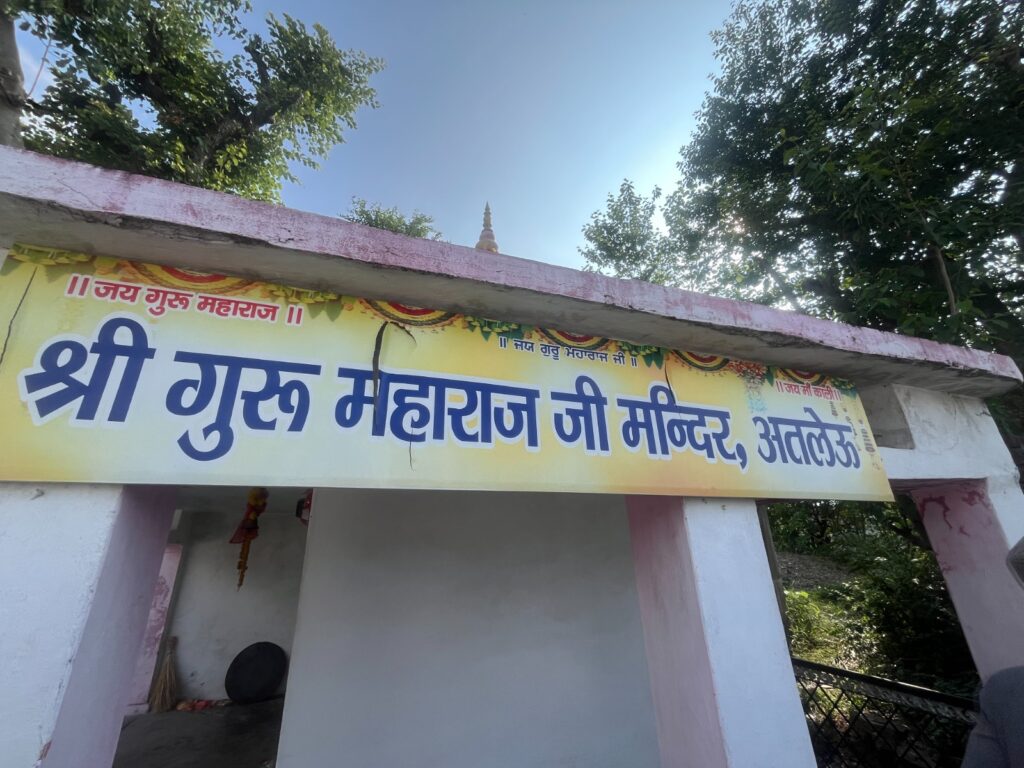Rediscovering the Forgotten Guru Shrines of Atleu Village, Uttarakhand
(A glimpse from Team Khoj-Vichar’s historical exploration)
ੴ ਸਤਿਗੁਰੂ ਪ੍ਰਸਾਦਿ ॥
When Team Khoj-Vichar reached the picturesque mountain region of Uttarakhand and arrived at the serene village Atleu, the entire atmosphere radiated a rare spiritual calm. With the cooperation of local Sikh sewadars, our team studied the village and discovered that the residents worship Sri Guru Gobind Singh Ji Maharaj as their ancestral deity (Kul-Devta).
At the center of the village still stands an ancient wooden Nishan Sahib—known locally as the Jhanda—draped in a white cloth chola, a symbol of deep reverence. What surprised us most was that no Guru-Sikh had ever formally visited this sacred site before.
According to the villagers, in ancient times the region suffered from leprosy and paralysis, but ever since Guru Sahib’s holy feet touched this soil, the ailments vanished completely. The devotees firmly believe this miraculous transformation to be the fruit of Guru Kirpa — the Guru’s grace.
The houses of Atleu still preserve the charm of traditional Himalayan architecture. Built of sturdy timber, their doors are remarkably small and secure. In place of regular doors, small window-like openings were designed so that no enemy could enter during an attack. Local legend relates that whenever an invader tried to peer through these windows, his head was instantly severed — a unique defensive design that makes these homes living examples of vernacular fortified architecture.
The village can be reached after a thirty- to forty-minute trek from Purani Kalsi. Nestled amid the verdant valleys of Uttarakhand, Atleu continues to preserve its ancient culture and the living memory of the Guru. Walking through its stone-paved lanes, one feels that each carved beam and engraved plank whispers tales from a bygone age. Near every house stand open verandas for cattle and earthen kitchens — silent witnesses to a time-honored way of life.
The villagers proudly affirm that they have worshiped Sri Guru Gobind Singh Maharaj as their Kul-Devta since ancient times. Every year, on the first Sunday of the month of Jeth (May–June), the entire community gathers to celebrate Guru Diwas. On this occasion they perform collective worship and distribute the traditional Karāh Prasād, prepared devoutly from jaggery, wheat flour, pure ghee, and water.
Thus, Atleu is not merely a geographical location but a living symbol of faith, heritage, and Guru remembrance — a place where devotion and history still breathe together.
A Living Folk Legend: Illuminated by the Collective Memory of the Guru
The identity of Atleu lies not only in its natural beauty but in the divine narrative of Guru Grace engraved in its soul. Villagers recount that in earlier times most children were born mute, deaf, or disabled, and leprosy was widespread. But when Sri Guru Gobind Singh Ji Maharaj sanctified the village with His holy presence, the land itself seemed reborn — disease and suffering disappeared, and the entire community was filled with devotion, peace, and prosperity.
An elderly resident shared with tearful eyes, “We are simple people; our faith in Guru Maharaj is unshakeable.” A young woman added that every year in May a night-long vigil (Jāgran) is held, featuring devotional songs, Ārti, and discourses in Guru Ji’s memory. In the previous year, the villagers offered a silver staff (Chhadi) to Guru Ji as a token of devotion.
Though the formal recitation of the Mūl Mantra is not performed here, the collective chant of “Guru Maharaj ki Jai! Guru Maharaj ki Jai!” echoes throughout the valley. This is a place where faith and surrender speak louder than words — a sanctified corner of the Himalayas where the Guru’s memory still glows in every heart.
As all the villagers and historian Dr. Bhagwan Singh “Khoji” gathered upon the steps of the village temple, the air resonated with the melodious voice of Sri Guru Nanak Dev Sahib Ji’s divine hymn:
Koi Bolai Ram Ram Koi Khudai ॥
Koi Sevai Gusaiā Koi Alāhi ॥¹॥
Kāran Karan Karīm ॥
Kirpā Dhār Rahīm ॥¹॥ Rahāu ॥
Koi Nāvai Tīrathi Koi Haj Jāi ॥
Koi Karai Pūjā Koi Siru Nivāi ॥²॥
Koi Paṛai Bed Koi Kateb ॥
Koi Oḍhai Nīl Koi Suped ॥³॥
Koi Kahai Turaku Koi Kahai Hindu ॥
Koi Bāchai Bhisatu Koi Suragindu ॥⁴॥
Kahu Nānak Jini Hukam Pachhātā ॥
Prabh Sāhib Kā Tini Bhaṭu Jātā ॥⁵॥⁶॥
The villagers explained the essence of this Shabad in simple words—
“There is only one Divine Lord; some call Him Ram, others Khuda. Some go to temples, others to mosques. Some read the Vedas, others the Quran. Yet, the one who realizes and accepts the Divine Will (Hukam) is the true knower of God.”
The villagers further shared that their food remains purely sattvic, in harmony with their ancient mountain traditions. According to an old legend, when an aged gardener was once asked, “When will leprosy vanish from this village?” he replied,
“The day Guru Maharaj arrives in this village with the Nishan Sahib fluttering high, from that day onward the village will be free of all diseases.”
And indeed, when Sri Guru Gobind Singh Maharaj graced this sacred land, no villager ever suffered from any ailment again.
During the conversation, Dr. Bhagwan Singh ‘Khoji’ addressed the villagers with deep reverence:
“Your ancient customs are your very identity. Preserve them faithfully, for they are the heritage of your faith — something we can only witness with admiration, but never truly claim as our own.”
He then shared a remarkable historical insight: Rishi Kalpi is said to have lived from the time of Sri Guru Nanak Dev Ji through the era of Sri Guru Gobind Singh Ji. Nearby lies the place called Purani Kalsi, where Rishi Kalpi once told King Medini Prakash:
“The Guru who shall grace this land will have arms that reach down to His knees — that shall be His true sign.”
Thus, when Guru Gobind Singh Maharaj visited Kalsi, it is believed with certainty that He also sanctified Village Atleu with His divine footsteps.
Renowned historian Bhai Vir Singh Ji, the brother of Rishi Kalpi, mentioned in his writings that Rishi Kalpi had witnessed the eras of all the Ten Gurus. This serves as historical evidence that Guru Gobind Singh Maharaj indeed passed through Kalsi and came to this village as well.
It is truly a matter of sorrow that, till this day, no Sikh institution or Sangat has reached this holy site. When the villagers celebrate Guru Diwas on the first Sunday of the month of Jeth, the Sikh community too should come here and join them in heartfelt devotion.
Even today, when the white Nishan Sahib waves proudly in the village and voices rise in unison —
“Guru Maharaj Ki Jai! Guru Maharaj Ki Jai!” —
it feels as though even the mountain breeze joins in this sacred chorus, whispering softly:
“This land is still sanctified by the grace of Guru Gobind Singh Maharaj.”
From Guru Nanak to Guru Gobind Singh – The Unbroken Tradition of Faith
If one looks deep into history, it becomes clear that the white Nishan Sahib is not merely a flag, but a symbol of purity and devotion. In Saket Mandi, a similar white Nishan Sahib waves proudly in the sacred memory of Sri Guru Gobind Singh Ji. In the rural regions of Chhattisgarh, the Nanakpanthi devotees too reverently raise the same white Nishan Sahib. Likewise, in remembrance of Sri Guru Amar Das Sahib Ji, a white flag also adorns the sacred site.
In Village Atleu, a white Nishan Sahib still waves upon an ancient wooden pole—standing as a symbol of faith. It reminds us that wherever Sri Guru Nanak Dev Ji and Sri Guru Gobind Singh Ji were revered as ancestral deities, the color white became the emblem of the soul’s purity.
Historian Dr. Bhagwan Singh ‘Khoji’ remarked:
“It is our misfortune as Sikhs that no Sangat has yet reached this sacred place. Stars can be counted, but not the number of souls whom Guru Maharaj has liberated.”
The villagers recount that in the past, leprosy and physical deformities were widespread in this region. On the request of Rishi Kalpi, Guru Gobind Singh Maharaj came to Kalsi, and from there, traversed the mountain path to reach this very village. The moment His divine feet touched this land, the entire village became free from disease—suffering disappeared, fear vanished, and the light of faith was kindled.
In the temple of the village, the sacred fire (Dhuna) still burns — a symbol of the eternal flame ignited by the grace of the Guru. Yet, it is tragic that these people remain unaware of the fundamental principles of Sikhism, for we have given them only worldly langar, not the langar of the Shabad (divine word).
This village, situated atop a high mountain peak, is extremely difficult to reach; even car engines overheat on the steep ascent. Still, Team Khoj-Vichar, accompanied by a few local Sikh sewadars, managed to reach the site. The Sikhs admitted that they too were visiting it for the first time.
Dr. Khoji said:
“We have forgotten how to search. But thank the Almighty Akal Purakh that even in this age, such unwavering faith still lives on.”
He believed that the people of this village are our true brothers in the Guru. He pledged that on the first Sunday of the month of Jeth in the coming year, he would return with his team and celebrate Guru Maharaj’s Day together with the villagers.
Addressing the Sangat, Dr. Khoji declared:
“Whoever believes in Sri Guru Nanak Dev Ji, whether living in the mountains or across the seas — he is ours! It is our duty to connect them to the mainstream of Guru Panth Khalsa.”
Near Village Atleu reside the Negi Sikh families — the descendants of those who were once known as the Neki Sikhs in ancient times. Through special efforts, Team Khoj-Vichar brought these Negi Sikhs for the first time to have the darshan of Sri Darbar Sahib, Amritsar — a truly historic moment. The deep roots of Sikhism continue to thrive even today amidst the mountains of Uttarakhand.
In a serious tone, Dr. Khoji said:
“Let us not fall into disputes. We must unite and serve Guru Sahib, for Sri Guru Nanak Dev Ji’s Sangat is still spread far and wide. As long as we breathe, Team Khoj-Vichar will continue discovering such forgotten Guru shrines and bringing them before the Sangat.”
The local residents narrated an ancient story:
Many generations ago, their ancestors once visited Amritsar. They returned carrying a Kara (steel bracelet) and were told —
“Worship this Kara; it will remove all your sorrows and pains.”
Even today, when they celebrate Guru Sahib’s Day, the teachings of Sri Guru Nanak Dev Ji flow from their lips like a gentle spring, and alongside, they also remember Guru Gobind Singh Maharaj. Their firm belief is that the spirit and message of the Gurus still live within the bodies of their forefathers.
Inside the temple, the pictures of Sri Guru Nanak Dev Ji and Sri Guru Gobind Singh Ji are beautifully placed. On the temple board, written in Punjabi, are the words:
“Guru Maharaj Ki Jai! Guru Maharaj Ki Jai!”
With deep emotion, Dr. Khoji said:
“Our misfortune is that we have not united our people — we have only raised buildings. We have demolished our ancient heritage and built new palaces, but severed ties with the souls that dwelled within those heritages. Remember — whatever breaks apart can never become a legacy.”
He further said:
“Many of our Sanatani and Muslim brothers too, today, revere Sri Guru Nanak Dev Ji and raise slogans in His name. I bow to all of them.”
Finally, he humbly appealed:
“Those who walk the path of fanaticism — please do not come to this place. Let these villagers continue following their sacred traditions. Just as when I go to Biranchipur in Odisha, I merge with its culture, so too lies true bliss in such harmony — therein are the visions of the Divine.”
Dr. Khoji concluded:
“Sikhi is not merely about wearing a turban or carrying a kirpan; it is the path of love, compassion, and selfless service. That very Sikhi still breathes upon these mountains.”
Thus, the journey to Village Atleu was not merely a recollection of history —
it was a living glimpse of the eternal Guru tradition.
And when, at the end of the journey, the village echoed with the resounding cries —
“Sri Guru Nanak Dev Ji Maharaj Ki Jai!
Sri Guru Gobind Singh Ji Maharaj Ki Jai!
Bole So Nihal… Sat Sri Akal!”
the entire atmosphere became filled with the light of Guru’s love and unity. The villagers bid Team Khoj-Vichar a heartfelt farewell — their faces glowed with contentment, and in their eyes shone that radiance which only the vision of Guru’s grace can bring.
